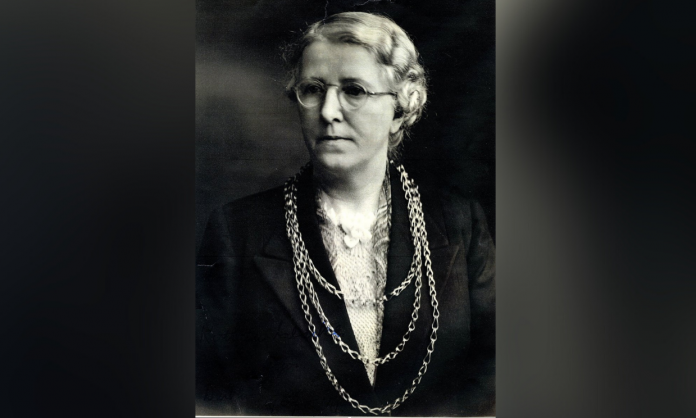by Aileen Atcheson
Of the many great women behind the great men of Easter Week and the War of Independence, we must include Kathleen Daly Clarke. Kathleen was born into a nationalist family in Limerick. The Daly family was very big. Kathleen had eight sisters and a brother, Ned, who was born after his father had died. Edward Daly, Kathleen’s father died in 1890, aged only forty-one. It was always thought his early death was brought about by his activities with the Fenians.
Daughter Kathleen set up a dress making business and her mother ran a successful bakery aided by her uncle, John. In 1901, Kathleen left Ireland, travelled to the USA and married Tom Clarke, a Fenian, who had been in jail with her uncle John. He was a member of Clann na nGael in America and worked in the organisation’s paper, Gaelic American. They had a son, John Daly Clarke. Kathleen was unwell for some time and they moved to Long Island where they bought a farm. Tom, who had been imprisoned for fifteen years because of his activities with the Fenian Brotherhood, wanted to return to Ireland. The returned to Dublin where they set up a newspaper shop and their second son, Tom Junior, was born there.
Tom Clarke was one of the leaders of the 1916 Rising. He was executed in Kilmainham Jail with Kathleen’s only brother, Ned Daly. Kathleen was expecting another baby at the time but lost it. She was a founding member of Cumann na mBan but she didn’t take part in the Rising, instead she was selected to know all the decisions of the Supreme Council of the IRB and the names of key men throughout the country.
She had to distribute aid to the prisoners dependants after the Rising had taken place. Her own family, she and three sons, no longer had an income. Their shop had been raided and looted. She went on to live with her family in Limerick for a while but in 1918 she and the children returned to Dublin.
She was arrested for alleged involvement in the “German plot” and imprisoned in England from June 1918 to February 1919 with Maud Gonne and Countess Markievicz. Neither of these ladies considered her their social equal but after a while in jail they became friendly and remained so for the rest of their lives.
When Kathleen returned to Dublin she sheltered men and women on the run and suffered much hardship because of this. A District Justice in the Republican Courts, she was also Chair of the judges on the Dublin circuit. She became an alderman on Dublin Corporation and served on many committees. Kathleen was very active in the White Cross, distributing and collecting funds to help look after the families who had been bereaved or left unemployed by the Rising.
Opposing the Treaty, she helped at the first aid station at the Gresham Hotel. As chair of a committee who tried unsuccessfully to negotiate a pact between the Anti-Treaty and Pro-Treaty groups, she was arrested and jailed. She ran a shop in D’Olier Street, Dublin which was raided frequently.
The Daly family in Limerick also suffered many raids, their bakery was taken over by Free State troops.
Kathleen’s eldest son was living in America for health reasons. In 1924 she went there to fundraise for the republicans. She was a founder member of Fianna Fail and served in the Senate. She opposed the Constitution of 1937. She was Dublin’s first female Lord Mayor. When she went to live in the Lord Mayor’s residence, she had the portrait of Queen Victoria removed. In 1965, she went to live with her son Emmet and his wife and family in Liverpool and attended the fiftieth anniversary celebrations of the 1916 rising in 1966 where she was presented with an honorary doctorate of law.
She died in Liverpool in 1972 aged 94. “Revolutionary Woman”, her autobiography was published in 1991, edited by her niece, Helen Litton.








